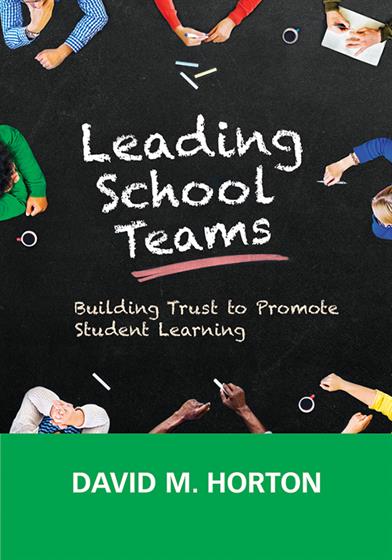
Hands-on, Practical Guidance for Educators
From math,
literacy, equity, multilingual learners, and SEL, to assessment, school counseling,
and education leadership, our books are research-based and authored by experts
on topics most relevant to what educators are facing today.

Leading School Teams
With ready-to-use tools, this guide will help you connect people, build trust, discover strengths, and clear barriers to improve teacher effectiveness—and ultimately raise student achievement.

- Grade Level: PreK-12
- ISBN: 9781506344928
- Published By: Corwin
- Year: 2016
- Page Count: 200
- Publication date: October 07, 2016
Price: $39.95
For Instructors
When you select 'request review copy', you will be redirected to Sage Publishing (our parent site) to process your request.
Description
The busy administrator’s guide to creating strong teams, changing culture, and improving performance
How effective is your team? Research shows that “teacher collective efficacy”—when all teachers are collectively engaged and focused on improvement—can do more to increase student learning than any other strategy. In fact, using powerhouse teams can achieve four years of student growth in a single calendar year. Horton’s practical guide will help you form your own dream team through:
- Short activities that require little to no preparation that you can use to deepen conversation at your very next meeting
- Step-by-step tools that will help your team move from identifying its biggest challenges to choosing and implementing successful reforms
- Strategies to enhance teamwork, trust, and collaboration so that your team becomes as effective as possible
Horton will help you connect people, build trust, discover strengths, and clear barriers to reach greater teacher and program effectiveness—and ultimately raise student achievement.
This book provides leaders and teams with a blueprint of how to work through a problem to find possible solutions while valuing each member of the team. This is not an easy task at any level and to have a resource to provide guidance for those tough situations is always welcomed.
Nicky Kemp, Assistant Superintendent
North Callaway R-1 School District
Leading School Teams allowed our team to address the lack of processes and the finger pointing and tension that went along with it. It was surprising how quickly the activities and discussion brought out the meat of the issues within our team. Because of the natural manner in which the issues were approached, team members felt respected and accomplished after each session.
Eric Dahlstrom
Principal, Dartmouth Middle School
Author(s)

David M. Horton
David has a Bachelor of Science in Biology and Master of Education from the University of California, Los Angeles (UCLA). He received a Master of Science degree in Administration from Pepperdine University and earned a Doctor of Education degree in Organizational Leadership from the University of La Verne. David resides in Southern California with his wife and two children.
Table of Contents
Acknowledgments
About the Author
Introduction
Sustained Improvement Requires Teams
What This Book Is—What This Book Isn’t
Quick-Start Diagnostic
Making a Selection
Putting It All Together
Activity Guidelines
Components of Team Activities
PART I. EXAMINATION AND IDENTIFICATION OF THE PROBLEM
Chapter 1. Learning Leadership
Leaders and Teams
The Realities in the Leadership of Learning
Application Activity 1.1—Assessing Your Organizational, Team, and Personal Strengths
Application Activity 1.2—Effective Learning Leaders
Application Activity 1.3—Strong Learning Teams Exhibit Common Characteristics
Conclusion
Chapter 2. A Problem Worth Solving and the Ideas to Solve It (the Filters)
Introduction
Ideas Are Fragile—Ideas Are Delicate
The Fosbury Flop, Ski Jumping, and Newton
Application Activity 2.1—Treating Ideas in a Learning Organization
Application Activity 2.2—Ideas That Don’t Work: Part of the Process
Application Activity 2.3—It Takes Other People Sooner or Later
Application Activity 2.4—Who and What You Have Around You
Deeper Use of This Chapter (Deeper Dive)
Conclusion
Chapter 3. Why Solve the Problem That Needs Solving (the Filters)
Introduction
Application Activity 3.1—What the Result of a Great Decision Looks Like
Application Activity 3.2— Reasons to Have the Idea in the First Place
Application Activity 3.3—The Problem That Needs Solving: Clear, Concise
Application Activity 3.4—The Role of the Leader in Developing Ideas
Application Activity 3.5—Harnessing the Forces Around You
Deeper Use of This Chapter: Deeper Dives
Conclusion
PART II—INTROSPECTION, BEHAVIORS, TYPES: THE HOW AND WHO TO SOLVE PROBLEMS
Chapter 4. How the Problem Is Solved
Introduction
Application Activity 4.1— Importance of a Process
Application Activity 4.2—Trust
Application Activity 4.3—Fear of Conflict
Application Activity 4.4—Commitment
Application Activity 4.5—Accountability
Application Activity 4.6—Attention to Results
Application Activity 4.7—Generating Ideas and Action Steps
Deeper Use of This Chapter: Reusable Prompts
Deeper Use of This Chapter: Deeper Dives
Conclusion
Chapter 5. The People Who Will Solve the Problem
Introduction
Application Activity 5.1—Know How to Build and Use People
Application Activity 5.2—The Chemistry of the Team
Application Activity 5.3—Managing the Creative Team
Application Activity 5.4—Handling Conflict in the Ideas From the Team
Deeper Use of This Chapter: Deeper Dives
Conclusion
Chapter 6. The People in the Room (the Types)
Introduction
The Assessment
The Basics
Application Activity 6.1—Part 1/Type 1: The Idea
Application Activity 6.2—Part 2/Type 2: Organization and Execution
Application Activity 6.3—Part 3/Type 3: Forces of Community
Application Activity 6.4—Part 4/Type 4: Leadership Capacity
Using the Four Types
Conclusion
PART III. FUNCTIONALITY OF THE TEAM
Chapter 7. People, Leadership, Support (the Fuel Sources)
Introduction
Fuel Source A: The People
Application Activity 7.1—Who
Application Activity 7.2—What
Application Activity 7.3—How (Coaching)
Deeper Use of This Chapter: Deeper Dives
Fuel Source B: The Resource of Leadership
Application Activity 7.4—Keep Things Moving (Management Leadership)
Application Activity 7.5—Keep People Moving (Leadership Management)
Deeper Use of This Chapter: Deeper Dives
Fuel Source C: The Supports
Application Activity 7.6—Gather, Collect, Assess
Application Activity 7.7—Feedback
Application Activity 7.8—Systems and Barriers
Application Activity 7.9—Performance
Deeper Use of This Chapter: Deeper Dives
Conclusion
Chapter 8. Team Dynamics, Blunders, Traps, Directions, and Connecting Dots (the Pink Elephants)
Introduction
Application Activity 8.1—Pink Elephants
Application Activity 8.2—Team Dynamics
Application Activity 8.3—The Blunders
Application Activity 8.4—The Traps
Application Activity 8.5—Ideas as Direction
Application Activity 8.6—Connect the Dots
Deeper Use of This Chapter: Deeper Dives
Conclusion
Chapter 9. Performance, Feedback, and Other Ways to Support, Maim, or Kill a Team (the Good, the Dangerous, and the Lethal)
Introduction
Application Activity 9.1—The Good: Selling the Idea: A Picture Is Worth 1,000 Words
Application Activity 9.2—The Good: Communication and Frequency
Application Activity 9.3—The Good: Ingredients of the High-Performing Team
Application Activity 9.4—The Dangerous: Planning Mistakes
Application Activity 9.5—The Lethal: Lack of Feedback, Feedback, Feedback
Application Activity 9.6—The Lethal: Mistaken Assumptions of People and Meetings
Conclusion
Chapter 10. Leadership, Support, Structure, and Conclusion
Leadership
Support
Structure—The Overall Structure: The First 15 Minutes, the Next 45 Minutes
Conclusion
References
Index
Reviews
"This book provides leaders and teams with a blueprint of how to work through a problem to find possible solutions while valuing each member of the team. This is not an easy task at any level and to have a resource to provide guidance for those tough situations is always welcomed."Nicky Kemp, Assistant Superintendent
North Callaway R-1 School District
“If you are a school or district administrator with the time, energy, and courage to take on the major concerns of your school/district and are willing to implement a plan with possible systemic change then this book is for you.”Jim Anderson, Principal
Andersen Jr. High School
"Chapter 4 of Leading School Teams allowed our team to address the lack of processes and the finger pointing and tension that went along with it. It was surprising how quickly the activities and discussion brought out the meat of the issues within our team. It happened in a natural way that it snuck up on the team and we were in the middle of addressing the real issues before we realized what was happening. Additionally, because of the natural manner in which the issues were approached, team members felt respected and accomplished after each session."
Eric Dahlstrom, Principal"Chapter 4 of Leading School Teams allowed our team to address the lack of processes and the finger pointing and tension that went along with it. It was surprising how quickly the activities and discussion brought out the meat of the issues within our team. It happened in a natural way that it snuck up on the team and we were in the middle of addressing the real issues before we realized what was happening. Additionally, because of the natural manner in which the issues were approached, team members felt respected and accomplished after each session."
Dartmouth Middle School
"Building effective teams at all levels of an organization is critical for long-term success. Nowhere is this more evidenced than in the principal coaching I do where building vital relationships and high-performing teams transcends traditional content and data and get to the heart of what we value in one another and our collective work. Dr. Horton has laid out a comprehensive–and palatable–approach to teaming that values the individual strengths of each stakeholder and lays the foundation for teacher enthusiasm and learner engagement."
Dr. Michael Roe, Principal"Building effective teams at all levels of an organization is critical for long-term success. Nowhere is this more evidenced than in the principal coaching I do where building vital relationships and high-performing teams transcends traditional content and data and get to the heart of what we value in one another and our collective work. Dr. Horton has laid out a comprehensive–and palatable–approach to teaming that values the individual strengths of each stakeholder and lays the foundation for teacher enthusiasm and learner engagement."
Riverside Poly High School
"This year I was faced with the challenge of starting a brand new community day school, changing the paradigm of how we educate expelled and at risk youth, and implementing curriculum and procedures that are truly new and innovative choices for our teachers. As I read through Leading School Teams I saw a few specific topics that I felt were key discussions to have as a fledgling staff, but sometimes folks can be hesitant in truly being honest about difficult topics. One of the best discussions we were able to have was in regard to the following prompt from Chapter 7 of Leading School Teams: 'Do we have a system to collect data on the program or initiative? Is it simple to use and simple to understand? Have results targets been determined before the program launch?' This prompt was able to facilitate a powerful discussion on how we are evaluating our progress, and how effectively we are meeting targets that we set at the outset of the year. As a staff we are looking forward to continuing these discussions using the same format and seeing the growth that will come from vibrant and honest discussions."Cristian Miley, Principal
ASPIRE Community Day School
"The strategies within Leading School Teams allowed our leadership team to develop a deeper understanding between our members. This enabled our team to create more effective connections with each other, improved our levels of communication, and strengthened our team's bond."Jeff Franks, Principal
Acacia Middle School
"Whether you are a new leader of a team, an established team in need of trust or a culture shift, a team where not everyone’s voice is heard, or a team without established systems, Leading School Teams provides the tools needed to create a highly effective team. This book provides powerful insight to practical activities that can be easily implemented with any team, at any stage, with an end result of productive change. Diagnose your team, engage in the activities and dialogue and watch your team transform."Leah C. Davis, Executive Director
Riverside County SELPA
"In order for any team or change effort to be successful, relational trust is key. In Leading School Teams, Dave Horton offers practical strategies to enhance relational trust in order to transform adult-centered systems into systems that put students at the center!"Paul Bloomberg, Chief Learning Officer
The Core Collaborative
For Instructors
When you select 'request review copy', you will be redirected to Sage Publishing (our parent site) to process your request.
